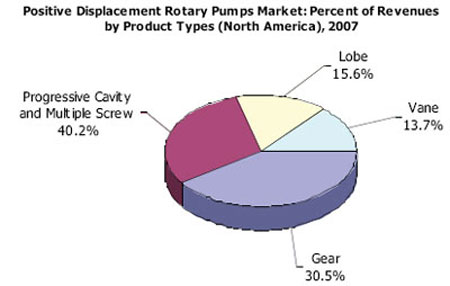Pumps & Systems, March 2008
Market Overview
Rotary pumps belong to the positive displacement (PD) pump family, which moves fluid using the principles of rotation. Rotary pumps are designed with small clearances between rotating parts which trap the fluid at the inlet port and force it through the discharge port into the system. Because of its design, the pumps operate at a relatively moderate speed to minimize slippage from the discharge side back to the suction side. Rotary pumps are subject to erosion if operated at high speed. Liquid slips reduce their efficiency.
The total rotary pumps market in North America generated revenue of $1.27 billion with a growth rate of 3.5 percent in 2007. This mature market had a significant amount of sales directed toward the replacement of existing pumps, as well as the development of new processes that require rotary pumps. The rotary pumps can be grouped into four main types (two have been further segmented): lobe, vane, gear (internal and external) and screw/progressing cavity pumps (single/multiple screw and progressing cavity).
Figure 1 shows each product type's revenue percentage for the North American rotary pumps market.

Product Types and Applications
Lobe pumps contributed approximately 16 percent to the total 2007 rotary pumps market. This pump type achieves positive displacement by means of a pair of rotors (lobes) that rotate in opposing directions within the housing. Separately housed gears ensure that the power is evenly transmitted to synchronize the lobes. Lobe contact is prevented by external timing gears present in the gearbox; therefore, wear in abrasive applications is minimal.
Gear pumps, the second most profitable rotary pump type, contributed approximately 31 percent of the 2007 revenue. The gear pump is a simpler design of rotary pumps. The basic external gear pump consists of two intermeshing gears housed in a close fitting case on separate shafts. One of the shafts is driven externally, and one is idle. During rotation, the medium is drawn into spaces or pockets between the gear teeth, carried around to the delivery side, and displaced under pressure.
High-pressure applications, such as hydraulics, are a primary application of external gear pumps. External gear pumps handle viscous and watery liquids where high pressure handling is required for thick liquids. The gear teeth come out of the mesh for a short time, and because viscous liquids are thick they require some time to fill the spaces between the gear teeth. Therefore, the pump speed must be decreased when pumping viscous liquids.
On the other hand, the internal gear pump consists of an inner gear situated inside an outer gear ring, with the tooth form chosen so that each tooth of the inner and outer is in contact. During rotation of the internal gear, a series of expanding and contracting gaps transfer the medium from the inlet to the outlet. Internal gear pumps are used to pump high viscosity mediums that are shear sensitive. Solids will likely damage the pump, but small-suspended particulates in abrasive applications are acceptable.
Progressive cavity and multiple screw pumps produced 40.2 percent of the revenue in the overall rotary market in 2007. The progressive cavity pump, also known as the single screw pump, is a continuous spiral or screw mounted on a central shaft that rotates in a channel or casing with close clearances. The screw and channel are positioned at a typical inclined angle of 30-deg from horizontal. Single-screw pumps are used for water raising and other applications. The length of the screws can vary up to 30-ft with large diameters. For applications requiring higher lifts, a number of screws can be arranged in a series.
Multiple screw pumps usually contain two or more screws running parallel in a casing connected by external gears. Effectively, these are multiple screws in one housing, which permits double the output and balances the end thrust on the shafts. These pumps are less noisy and discharge is pulse free, which is advantageous when handling liquids in locations where gases are present. Therefore, this type of pump is used extensively in industries such as oil and gas recovery, oil and gas distribution, chemical processing and pharmaceutical processing.
Vane pumps are available in various forms but the most common are rotary, sliding and flexible impeller. A sliding vane pump consists of a rotor with radial slots within a circular housing. Each slot carries a rigid vane that slides freely along its axis. As the rotor rotates, the vanes move out to the housing, creating a pocket between the vanes. Therefore, fluids move into the inlet side and exit the outlet side. Flexible impeller vane pumps are used to handle shear sensitive fluids and fluids containing solids. They are suitable for pumping almost any liquid and have become a popular choice for pumping water in marine applications. Other applications are the food and beverage processing industries.
Key Points
- The flow of the fluid is independent of pressure. The flow rate can be changed without upsetting the pump's efficiency.
- The pump can handle high viscosity fluids efficiently.
- The pump is self priming.
- The pump allows a smooth pulse-free flow of the liquid into the system.
- The pumps enable a non-shearing action that will not degrade sensitive petrochemicals and polymers
Rotary pumps are designed to work best with viscous (thick) fluids because the viscous fluid fills the clearance areas and the pumping cavities. The less clearance in a rotary pump, the better it works.
This mature market is dependent on technology innovation and niche applications, which are driving growth with new construction activities and expansion of existing plants. Sluggish growth rates and high energy costs in North America have spurred the shift of major end-user industries (such as chemical and oil and gas) to low-cost manufacturing countries.
Consequently, manufacturers must produce highly efficient and affordable pumps. During 2007-2010, competition should be high; manufacturers will likely concentrate more on solutions-based approaches and on consolidating market shares through strategic acquisitions.

